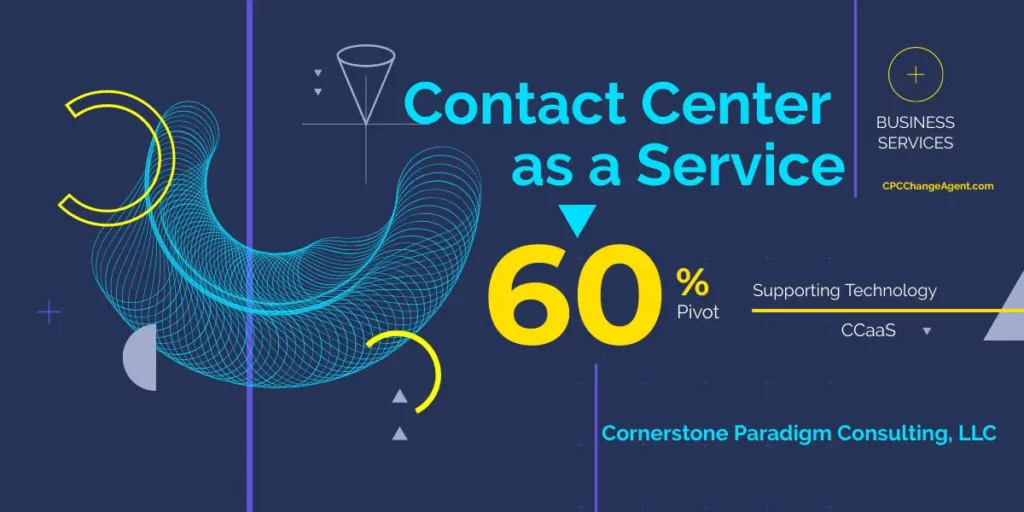Empowering Customer-Centricity: The Rise of Contact Center as a Service (CCaaS) in Delivering Exceptional Client Experiences
In line with the shift from business-led to customer-oriented commercial transactions, organizations understand that the customer truly is king. This acknowledgment has led to a significant change in the way businesses operate, with customer satisfaction being the top priority.
As such, organizations are investing heavily in improving their customer service experience. This is not just limited to having friendly and helpful staff but also involves incorporating technology and data analytics to better understand and cater to their customers’ needs.
Delivering 360-degree client experiences has therefore become a core business priority as companies tussle for the attention and loyalty of consumers – and the increasing uptake in Contact Center as a Service (CCaaS) is a feature of this arms race.
With the rise of e-commerce and online shopping, customers have more options than ever before. This means that businesses need to work harder to stand out and retain their customer base. And one key way to do this is through exceptional customer service.
In the past, contact centers were seen as a necessary but often frustrating aspect of doing business. However, with advancements in technology and the shift towards a more customer-centric approach, contact centers are now being viewed as strategic assets.
Through the use of data analytics and artificial intelligence, businesses can gain insights into their customers’ preferences and behavior, allowing them to personalize their interactions and provide a seamless experience. This not only improves customer satisfaction but also increases loyalty and retention rates.
CCaaS enables highly-targeted consumer experiences, offering personalized ticket resolution and cloud-based management tools that improve customer satisfaction and agent efficiency.
However, the innovative nature of this cloud-based solution has led to numerous organizations grappling with comprehending the essence of Contact Center as a Service (CCaaS) and its superiority when compared to traditional on-premises systems. The flexibility, scalability, and cost-effectiveness inherent in CCaaS offer a transformative approach to customer service operations, enabling businesses to adapt swiftly to evolving customer needs and market dynamics.
What is Contact Center as a Service?
CCaaS (Contact Center as a Service) revolutionizes customer experience with its cloud-based solution. Offering omnichannel support tools tailored to individual needs, it presents a comprehensive customer communication package. This includes features like Interactive Voice Response (IVR), Voice over Internet Protocol (VoIP), self-service options, and a range of other innovative tools designed to enhance customer interactions and satisfaction.
Being cloud-based, Contact Center as a Service (CCaaS) offers businesses the opportunity to design highly personalized client interactions. This allows organizations to tailor each phase of the customer journey, ranging from post-sales activities to regular customer assistance. Moreover, leveraging the scalability and robust infrastructure of the cloud ensures seamless operations and enhanced customer experiences across various touchpoints.
It’s worth noting that cloud-based contact centers provide different services from call centers. While they both focus on delivering customer support, contact centers provide potentially broader engagement services. For example, call centers typically handle voice calls only, compared to contact centers that include phone, email, SMS, and social media engagement.
Likewise, unlike premises-based contact centers, CCaaS solutions can be deployed in mere days or weeks – and at relatively affordable costs – which makes them attractive to most businesses. Apart from this, organizations access CCaaS services on a pay-as-you-go basis, letting them modulate customer support demands in line with business ebb and flow.
According to research firm Metrigy, more than 60% of companies pivoted to single or multi-tenant CCaaS technology during the pandemic. As Gartner reports, contact center revenues will exceed $15 billion by 2024, reflecting the increasing adoption of this technology.
CCaaS vs. on-premises and other SaaS solutions
Cloud-based vs. on-premises
Premises-based contact centers typically rely on in-house agents using company-owned software and hardware to meet customer support demands. As a result, they require considerable upfront costs related to IT resources, physical office space, installation of servers, and ongoing maintenance.
Organizations with on-premises systems enjoy low latency and total control over their infrastructure. But on the flip side, they maintain a potentially expensive system that may be prohibitive to small or high-growth companies.
Comparably, cloud-based contact centers are hosted customer experience solutions stocked with every customer engagement feature organizations require. In addition, companies can choose from various scalable subscription plans that involve no upfront costs and can be launched rapidly.
Organizations also benefit from excellent integrations that let them link other platforms, like a CRM, with their contact center solution. While CCaaS systems do not bring the control and independence of on-premises contact centers, they provide high availability and quick access to comprehensive customer support solutions.
CPaaS and UCaaS vs CCaaS
CPaaS means Communications Platform as a Service. It is a cloud-based service that lets organizations add and customize communication channels like video, voice, or messaging to an existing customer or business application. For example, a carpooling app can purchase a CPaaS add-on to enable customers to chat with drivers or call them in-app.
On the other hand, UCaaS stands for Unified Communication as a Service. The primary goal of these platforms is to provide a central interface for business and customer communications. Companies with a growing communications stack can use UCaaS interfaces to simplify and centralize internal and external interaction, improving collaboration and productivity.
Meanwhile, CCaaS provides a complete customer experience solution, available to organizations on a scalable pay-as-you-go basis.
Common CCaaS use cases
It’s now clear what CCaaS does for businesses, but when should your organization consider employing this solution for customer engagement? Some of the common scenarios for adoption are when:
- Your company is newly established and would prefer to avoid the considerable costs of founding and outfitting in-house contact center resources
- You are experiencing rapid growth, and support needs are exceeding your current capacity
- You plan to extend or overhaul your current communications platform to exploit the omnichannel and customized potential of CCaaS solutions
- You intend to introduce flexibility and federated access to your customer engagement stack for remote work or distributed teams
- You want to facilitate greater transparency into your contact center by leveraging the analytics capabilities of CCaaS platforms
Any one or more of these factors can make pivoting to cloud-based contact centers a shrewd business move. Furthermore, you may consider moving part of your customer support system to the cloud while maintaining an on-premises technology stack – often referred to as a hybrid arrangement.
Benefits of CCaaS for businesses
A primary allure of CCaaS systems is the ease and speed of pivoting to cloud-based contact centers. It requires very little backlift and can be completed within weeks. Additionally, organizations contemplating a transition to the cloud can anticipate the following benefits:
- Wider support coverage: As Hubspot reports, consumers employ up to thirteen separate channels to contact businesses. CCaaS solutions allow organizations meet and interact with clients across multiple communication channels, which is increasingly a basic requirement for excellent customer communications. Cloud-based platforms also increase the likelihood of first contact resolution, which is critical for customer satisfaction and loyalty, according to 67% of consumers.
- Lower operational costs: Without the burden of hardware costs, office space rent, and in-house salaries, companies can save thousands of dollars with CCaaS solutions. Given that for every $1 spent on infrastructure, organizations pay an additional $2 on maintenance, those savings can add up quickly. Since CCaaS lets companies pay for only services they need, they can avoid excessive access fees and unwanted features.
- Growth on demand: Contact as a service can be rapidly ramped up or down to meet changing customer support demands. Companies experiencing a surge in customer interactions can affordably and quickly unleash additional resources that can be scaled back as demand lessens.
- Team flexibility: Since CCaaS solutions are cloud-hosted, agents can access them from any location or device, which does wonders for your team’s flexibility and work-life balance. Conversations can be synced across channels, ensuring seamless work regardless of physical location or time zone.
- Increased productivity: The efficiencies and lower costs that CCaaS enables ultimately stack up and promote greater agent productivity and efficiency. Analytics features also provide granular access into customer engagement, letting businesses see what agents and departments are doing and how the process may be optimized.
Deploying a CCaaS solution
Your CCaaS solution should improve customer outcomes overall while streamlining business processes and maximizing resources. But how do you determine what solution best fits your needs and peculiar use scenarios?
Making the right choice starts with engaging an expert to determine where and how a CCaaS solution can add value to your customer fulfillment process. An expert will advise you of the key use cases for your business and the most optimal way to proceed.
This might include guidance on the vital CCaaS features that will complement your business operations, customer experience design, or execution of a planned customer engagement approach that ensures better overall outcomes.
If you still have questions, feel free to reach out to one of our experts today for a consultation without any obligation.







